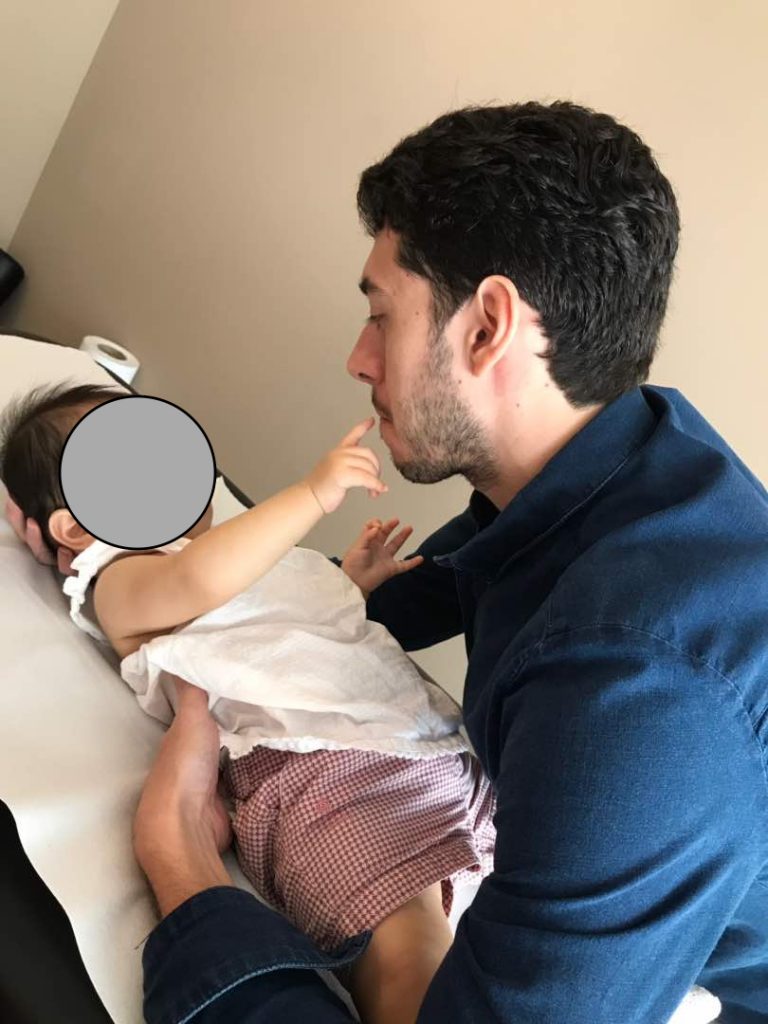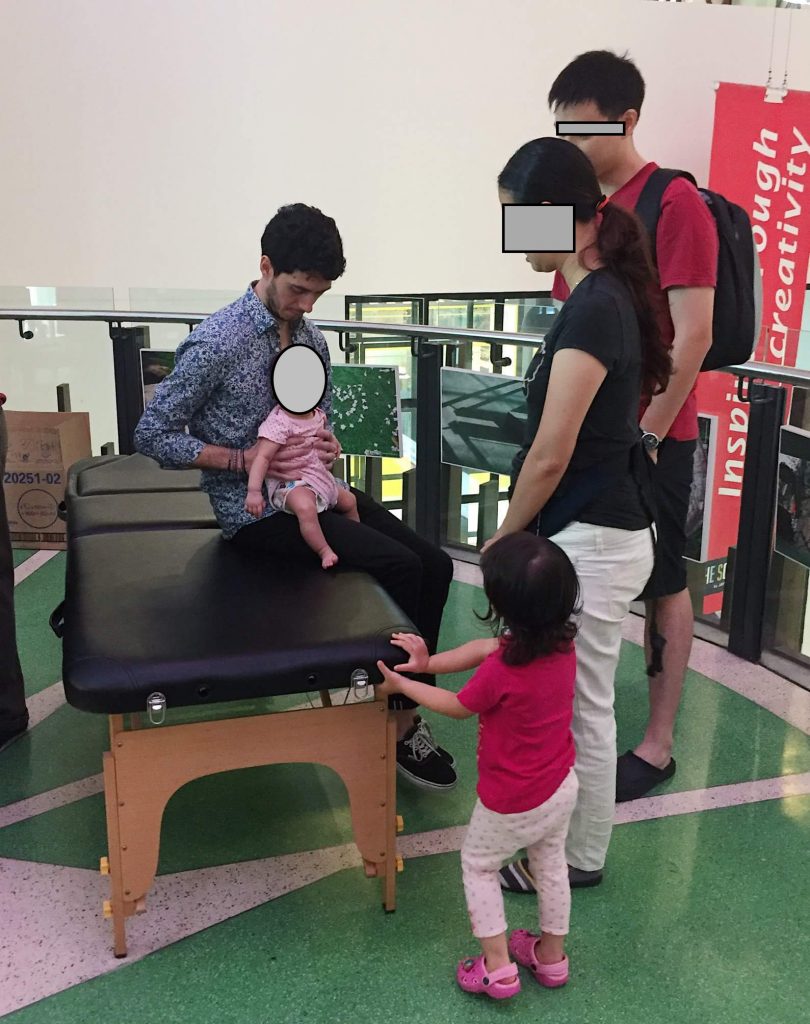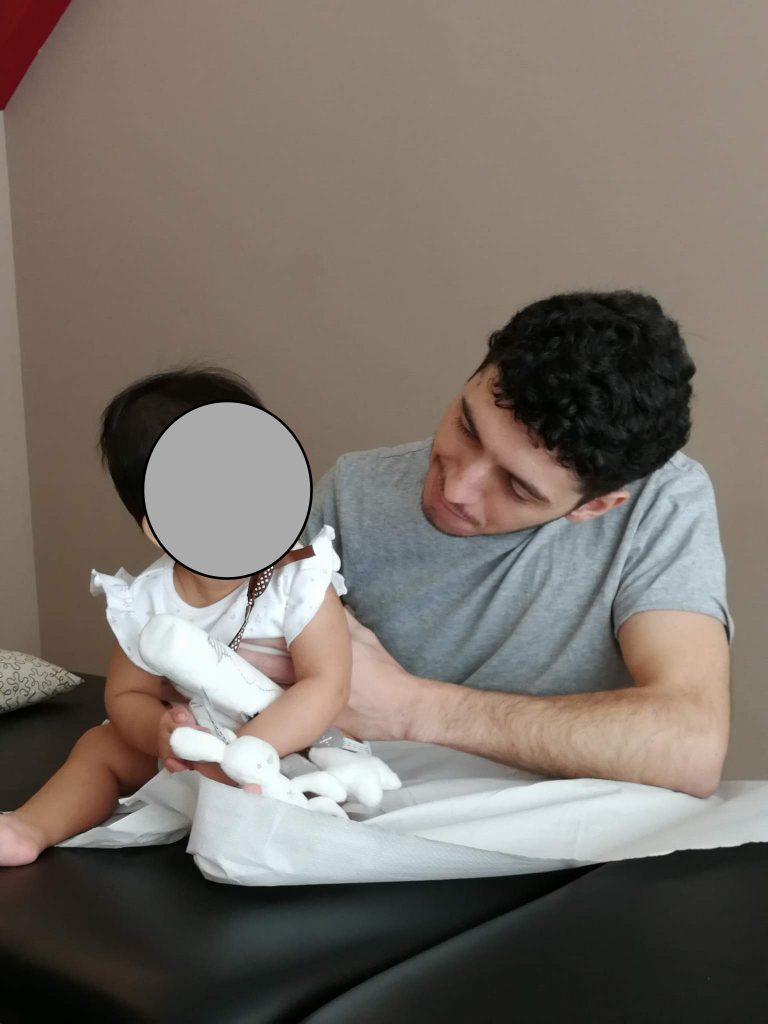Treating babies is one of my skills. I have been working as an osteopath for more than 10 years (I know, I still look like I am 25 years old). During those years, I have given treatments to many babies and toddlers. I wouldn’t say that I am specialised in paediatric osteopathy, as I treat adults too. But I’d like to think that my short experience might help a few people to better treat babies and toddlers. After all, I have treated thousands of babies either in France, Malaysia, and now in Ireland.
I’d like to share a few advice that might help younger manual therapists, craniosacral therapists, osteopaths, or anybody who doesn’t feel comfortable with treating babies. In my opinion, paediatric osteopathy is not about techniques, it is about being human.
Many osteopaths are not comfortable with treating babies
Most osteopaths (French and UK trained osteopaths at least) received training in paediatric osteopathy. Still, along my career, I have met many osteopaths who find it difficult to treat babies. In most cases, those osteopaths know a lot about paediatrics, but they simply don’t feel comfortable because of a very simple reason: they don’t know how to manage tiny patients.
It’s a shame as many of them could help many more people by doing so. Helping a baby is helping a whole family. And I hope that this article will help both manual therapists and parents. I am still trying to become more successful here.
Adaptation is key to treating babies
If you can take away one thing from this article, it has to be this one. You have to adapt to the baby (actually, it is true for adults too). This is much more important than all the lame theories you learnt at school about cranial osteopathy. Much more important than your belief about how you can move the bones of the skull. I know, most osteopaths love me when I say that haha.
Babies get hungry, babies need to be changed, babies need to be carried etc. You might have been taught for 5 years how to treat patients on a massage plinth, but might not be able to keep a baby on the table for more than two minutes. So you need to adapt. You need to meet your patient where they are, you need to follow their pace, to change the position you are working in etc.
Meeting the baby
Take time to say hi! Do not jump on the babie’s skull. Look at him, play with him. Touch the tummy, talk to the baby. You are interacting with a living being here, you need to make them feel comfortable.
If you really learn how to listen, you can get information about what’s happening even before touching the baby. Or by just carying the baby to the table, you might already know where you’ll start the treatment from. This takes about 2 seconds for you to have an idea about what’s happening. So take your time, deepen your experience. Both of you need to feel comfortable.
Be ready to work differently when treating babies

You do not need the baby to be lying down on their back. Think about all the possibilities you have: On their back, on their tummy, on the sides. But you can also sit them up on the table. What about sitting them up on your legs? This would allow you to move your legs at the same time.
You can also get them to sit on their parents legs. Some of them just don’t like to see you, so that could be a great way to avoid eye contact. Be creative! The only rule is for the baby to feel comfortable.
And in order to do that, you can treat them while carrying them. Yes, you can do that! And you can use any carrying position, so that increases a lot your possibilities! And if you believe that you cannot treat them while carrying them, I would argue that you do not have a problem of technique, but a problem of philosophy. You might still believe that you are pulling on muscles, and pushing bones back in place. You might still believe that your patients are muppets. Because if you hold space for them, this is definitely not an issue. But that requires you to kill the beast first and get rid of many stupid things you’ve been told during your studies.
As much as possible, do not let them get unsettled
That’s the whole point of being ready to adapt your position to the baby. Paediatric osteopathy is not meant to get a baby to cry.
I sincerely believe that it is your responsibility to adapt to the baby in order to get him to relax as much as possible. It can sometimes get tricky and there are no magical tools that you can use. Everybody’s different, and what worked for the first session might not work for the second one. But if you can prevent the baby from crying, then this will definitely be a great way to improve your treatments.
Let them feed when they are hungry
This is serious. You won’t be able to fight against a hungry baby. When they are hungry, they need to feed.
In order to avoid that issue during a session, you can try to book an appointment based on when the baby is not supposed to be hungry, just after a feed for example. But it is sometimes not possible. What you can do is to get the baby to latch on during the treatment, and if the mom and yourself feel comfortable with that, you can easily work at the same time. It is even easier to do if the baby feeds on bottles.
Treating a baby while they are being fed is actually a very lovely moment that often leads to a baby being very relaxed. 2 minutes of relaxed treatment can be better than 15 minutes of treatment with an unsettled baby.
Respect the rhythm of the treatment

You need to respect the rhythm. You need to become better at that. That’s a key for treating both adults and babies. You need to listen more and to feel when you have to slow down or when you can push a bit. You need to learn when a baby is hungry and when a baby is just bored and needs you to carry him around.
The treatment is not only what is happening under your hands. The treatment is what is happening in the room. You are working with a living system that you need to help move its way out of a problem. Most babies are brought to us because they cannot find a solution to their issues. You are here to create an environment that helps their body to react towards less tensions.
That’s the reason why you need to respect the rhythm. You need to know when to start, when to play with them and when to stop. Make a step back and listen more.
This is exactly the same as a meditation. It’s a manual meditation if you want.
You need toys
Unless you have a very funny face like mine, or unless the parents are extremely good at singing, you will need toys.
So ask your patients to bring some, or have some at work (that you can easily clean, obviously). I know, this might sound obvious but you’d be surprised at how many manual therapists who work with babies don’t have a single toy in their clinic.
Treating babies…and their parents
It is important to understand that. When you work with babies, you work with their parents. And you have to keep in mind several things about that.
Most parents are exhausted
Honestly, this is always overlooked. And even more the mom if she’s breastfeeding. This should almost be framed in our treatment rooms.
In most cases, they have to deal with an unsettled baby, and they do not sleep enough. I lost count of how many parents could fall asleep by just watching me treating their babies. So you need to keep that in mind and talk to them in order to know how they are doing.
Parents have no idea what you are doing
Let’s face it, most people have no idea what osteopathy can do for their babies. And most people have no idea how we can do the things we do. I won’t even start talking about how dubious our osteopathic models are.
But you need to address that. You need to ask them what they know about osteopathy and to explain them what you are going to do. You need to explain every single thing. The fact that it is not painful, the fact that you will adapt to the baby and try not to let the baby cry. How many sessions you think will be necessary to help the baby and why.
This is serious. You need to feel how parents are reacting to the treatment too. Talk to them just like you talked to the baby at the beginning of the treatment. After all, they are kind of big babies too.
Parents are under a lot of social pressure
Everybody has an opinion about their baby. The mother in law, the sister, the other osteopath they saw. They are scared that their baby won’t have a happy life, or that they are not up to the task.
Give them space. Stop with dubious diagnosis. Keep it simple and bring them back to what you see. The baby cannot turn his head to the left? Tell them that you are helping the baby to find a solution to turn their head to the left. That’s all you need.
Also get them to feel more comfortable with their choices and with how they do things. People have opinions and will always have. Your clinic is a place where they can rest from that too.
Imply them in the treatment
Treating babies is a team work. You need to imply the parents in the process. Give them things to do at home. Show them how to massage the back of the baby, show them how they can carry their baby, how to do tummy time. Show them a few simple osteopathic techniques to relax the shoulder shoulder for example. Or how to massage the neck of the baby while latching on their finger etc.
And give them space about it. Tell them that they are a team with their baby and that they are going to learn how to work together. It might take time but they’ll figure it out. So build their confidence, especially if that’s their first baby.
I show a lot of things during my treatments and I always check on how comfortable they feel about practicing those exercise at home. Guess what they always tell me: “I am not sure I am doing it right”. That’s what I am talking about. You need to know that most people don’t feel confident enough and to bring them there.
That’s why you need to keep things simple: simple movements or exercise, and simple explanations.
Make sure they understand
Ask them to rephrase what you did during the treatment and what you explained them. You cannot let them leave without being sure that their questions are answered and that they understood what you were trying to achieve.
And talk to them during the treatment, tell them what you are working on. This can help tremendously.
Treating babies, conclusion

There’s probably much more to say about that and I will edit that page as often as possible. But here are the main points:
- Adapt to the baby
- The parents are part of the treatment
If you follow those advices, you will get more and more babies to fall asleep in your arms during your treatments. Of course, it is sometimes a bit more difficult than that. But that’s already a good start for who feels like building up confidence in treating babies. I hope that helps some of you.
When it comes to techniques, you’ll find hundreds of CPDs. In my opinion, the only thing that matters is to hold space. Treating babies requires patience and stillness, but it is a wonderful practice as you help more people than you know by doing so.

About Jules Rampal
Meditation teacher and osteopathI am an online meditation teacher and an osteopath currently working in Gordes, France. My courses are for people who want to learn meditation with guided sessions, and for therapists who want to delve into the way they feel and the knowledge they can gather for their clients.
Book an osteopathic session here
Learn more about me here
Leave a Reply